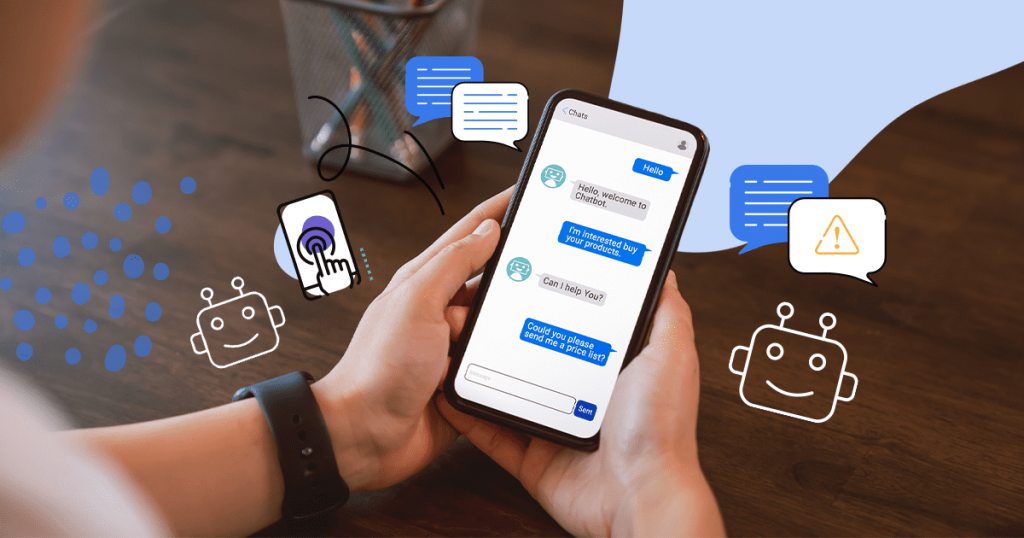Every business has unique goals and objectives, so they need different marketing tactics to meet their objectives.
Tools like artificial intelligence, otherwise known as AI, can help brands by providing customizable integrations and platforms that align with your business’s specific goals.
Chatbots are one example of an AI tool that many businesses have added to their websites to help meet increasing customer demands without taking time away from human team members.
But with so many different chatbots available on the market today, which is the right one for your business?
Let’s take a look at 6 types of chatbots and see which is the best fit for your brand.
- What is a Chatbot?
- 6 Types of Chatbots You Need to Know
- How to Choose the Best Chatbot for Your Business
- Wrap Up
What is a Chatbot?
At its core, a chatbot is an AI application that simulates a conversation with your website visitors.
By using natural language processing technology, chatbots can understand conversations and give helpful replies.
Based on your customer needs, they can be as simple as single responses to complicated personalized responses.
Chatbots can provide your customers with a convenient experience while reducing the burden of repetitive, time-consuming tasks on your team members’ workloads.
They can help to ease customers through your marketing funnel and provide quick customer service responses to help keep your customers happy with your services.
As digital marketing has evolved, the demands of customers have grown to expect quick responses, fast answers, and communication at a moment’s notice.
Chatbots help to bridge the gap during after-hours, provide immediate responses, and can deal with many different customers requests all at once — all of which help improve your overall customer experience.
6 Types of Chatbots You Need to Know
There are a few different types of functions that chatbots can provide, and you should be aware of them.
Once you have a clear understanding of the types of chatbots that are available, you can decide which are best for your businesses.
1. Support chatbots
One of the most common types of chatbots is support bots.
These applications help support your customers when they have FAQs and provide additional context to help support the customer’s journey.
Support chatbots help your business with key functions, like supporting customer relationships, replying to common emails, and adding more interactive elements to website browsing.
2. Skills chatbots
In addition to answering questions, some chatbots have built-in skill sets to answer basic commands.
This can help your customers on interactive platforms for your business.
Commands like “open X application” or “play X song” can help increase the engagement your customers have on your website, improving their experience and bringing them back for more.
3. Smart AI chatbots
While many different chatbot applications are simple answer-and-response interfaces, there are also smart AI chatbots that take things a step further.
By using machine learning, smart AI chatbots can process complex questions and actually learn and grow to be smarter.
Smart AI is a great application for large brands that manage a wide variety of incoming requests from a large group.
They are able to support questions and requests that go beyond simple FAQs and therefore can help your brand manage more complex customer relationships.
4. Scripted chatbots
If your brand doesn’t need the complex AI capabilities of a smart chatbot option, there are also simpler options.
The chatbot uses a pre-programmed script to respond to specific inputs with clear responses.
Scripted chatbots often use specific prompts to encourage customers to give the inputs that they need to provide a response, or will have customers choose from a list of options rather than freely typing.
If queries go beyond the script, the bot will often connect customers to a live chat or give contact information to ask their detailed questions.
While these types of chatbots are more limited, they can help customers with common requests and are an easy type of chatbot that you can quickly implement onto your site — often at much lower costs than smart AI.

5. Pre-Built chatbots
Chatbot applications often come with pre-built functionality, making it easy to implement and get them up and running quickly.
These are often scripted chatbots that just need simple inputs to match your brand’s needs.
Once you’ve applied the right responses, the bot is ready to go.
Pre-built bots are great for businesses that want to start right away with their chatbot strategy, are already struggling to manage incoming requests, or have busy teams that can’t dedicate an abundance of time to building a bot script from scratch.
6. Customized chatbots
In addition to the pre-built options, many chatbots also come with do-it-yourself functionality that you can customize from beginning to end.
With help from tools like drag-and-drop designs and templates, you can still build a chatbot for your business needs that isn’t using a premade script.
You can also hire a chatbot agency that specializes in creating custom code for your chatbot or works in developing smart AI that has machine learning capabilities beyond a simple script.
How to Choose the Best Chatbot for Your Business
With so many different options for chatbots available to brands, it can be confusing to navigate through your choices to pick the right one for your business.
However, there are a few ways to approach selecting the types of chatbots that will be best for your goals.
Define the problem
Before comparing pricing between chatbots and looking into implementation timelines, you need to know the problem your chatbot is going to solve.
- Do you need a bot to direct customers to the right salesperson?
- Are you trying to answer FAQs?
- Or are you trying to convert your users to the next stage of your funnel?
Once you know what you want to accomplish, you can begin to narrow down your options.
Always put the customer at the front of your strategy, since they are the ones who will be interacting with the chatbot on a daily basis.
Determine where your bot should go
Chatbots can be integrated into many different platforms, but you may not need to have that many.
Try and determine where your customers start to run into issues that a chatbot can help.
Think through your chatbot strategy as a whole, and make sure you create a holistic experience for customers.
If you do decide that you need a bot on multiple channels, then that will help you further narrow down your options to chatbot applications that can be incorporated into different areas.
Be aware of your team’s workload
Some types of chatbots are reliant on different input from your team members, or end up directing your customers to live chat options.
Even smart AI chatbots can reach a point where they cannot answer questions and a human is needed to continue to work with the customer.
Before picking the types of chatbots that will meet your goals, measure the workloads of your team and make sure that the new AI doesn’t accidentally overload your team.
Think through your budget
Different types of chatbots will have different costs associated with them.
Sometimes chatbot plug-ins might be included on your website platform, or you can find inexpensive applications that can integrate with your website.
If you want to have a smart AI application or more advanced machine learning and natural language processing capabilities built into your chatbot, then your budget will need to increase.
Scripted, simple chatbots are much less expensive.
Determine which type is best for your goals, then search for solutions that suit your budget needs.
Wrap Up
Chatbots fulfill an essential need in marketing and customer service communication.
They help to organize, answer, and direct customer concerns and questions without adding to the workload of your team members.
Different types of chatbots are available 24/7 and can help improve the experience of users in your customer journey pipeline.
While chatbots are an excellent tool, they are only a small part of the possibilities artificial intelligence can bring to your business.
To learn more about the power of AI, watch our webinar recording with Paul Roetzer where we discuss the role of AI in marketing.
You’ll learn how AI can be used in different applications, ways to combine humans and technology, and insight into the future of technology in marketing!








